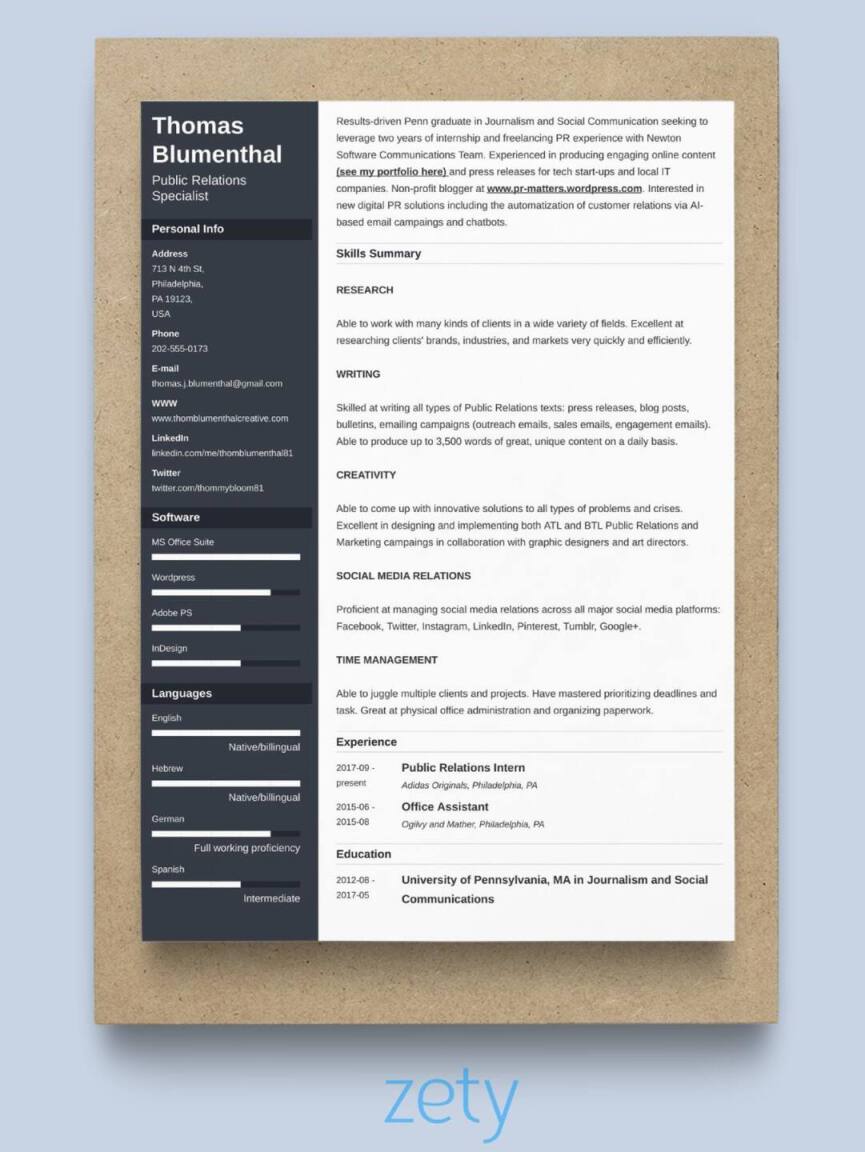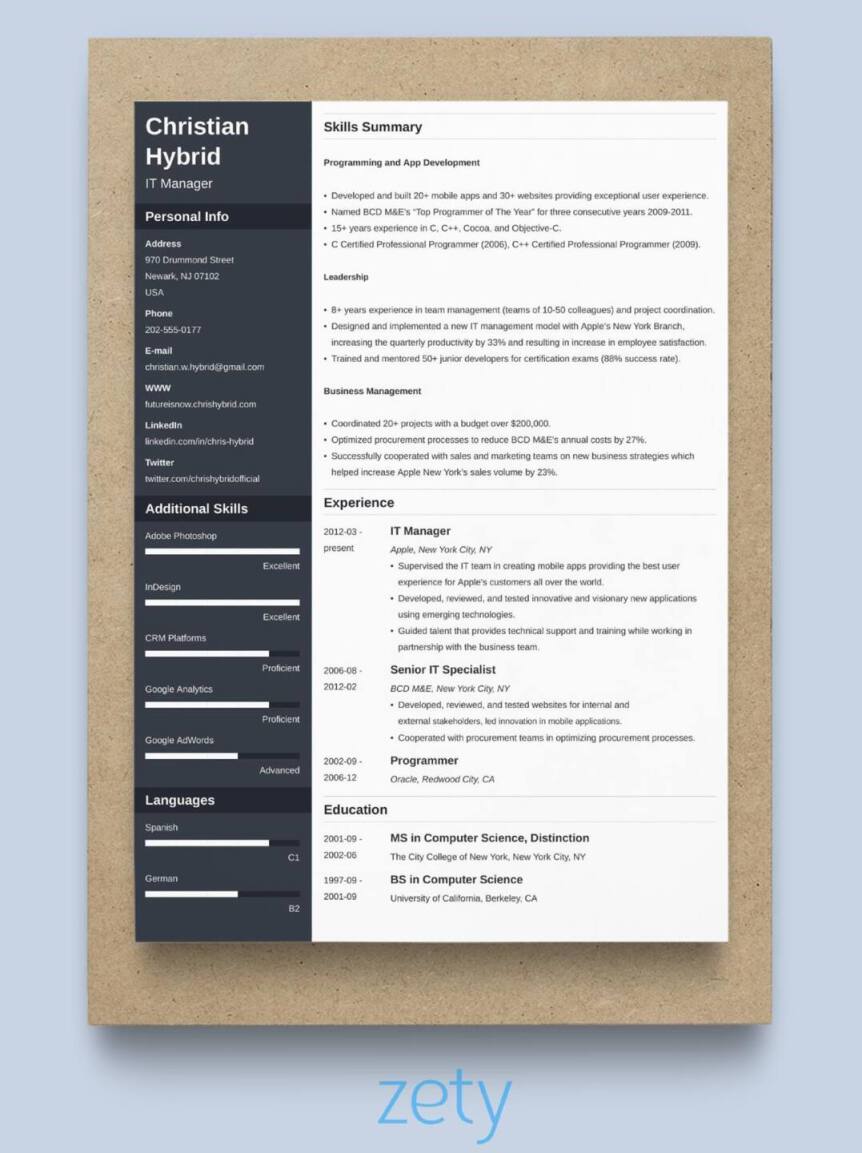
What Does the Best Resume Look Like in 2023
Not sure what your resume should look like to impress recruiters and land you that dream interview? You’ve come to the right place to find out. See for yourself.

The way you structure your resume could mean the difference between landing an interview and rejection. But do you really know how to organize your resume in the most effective way?
A recruiter will spend only a few seconds scanning your application documents.
If your resume structure is confusing and disorganized it will end up in the rejected pile.
You don't want this.
Fret not.
In a couple of minutes, you'll know exactly how to make an unforgettable first impression on any recruiter.
This article will show you:
Want to save time and have your resume ready in 5 minutes? Try our resume builder. It’s fast and easy to use. Plus, you’ll get ready-made content to add with one click. See 20+ resume templates and create your resume here.
Sample resume made with our builder—See more resume samples here.
1
Cut to the chase—
There are three main ways in which you can structure a resume:
Here’s what the general resume structure of each of these types looks like:
Remember—
There’s no such thing as the perfect resume structure.
Your resume structure will look different depending on your work experience, career path, and the things you want to highlight.
If you take a good look at the image above, you’ll notice that each resume’s central section is different.
In the case of the chronological resume structure, the majority of space is taken up by experience. On the functional resume, the skills section is the largest. And the bulk of the combination resume’s real estate is occupied by skills and experience.
And this is exactly how you should choose the best resume structure for your purposes:
Now—
Let’s take a closer look at each type of resume structure:

The chronological resume is easily the most versatile and popular resume structure with job seekers and recruiters alike.
Why?
First and foremost, it’s very easy to scan.
The latest study by the Ladders shows that recruiters typically spend about 7.4 seconds looking at a resume.
This isn’t much time, is it?
That’s why a good resume structure is one that:
And this is exactly how the chronological resume works.
Here’s how to organize your resume so it has a chronological resume layout:
Remember what the most important section of a chronological resume is?
Work experience.
So—
Here’s how to organize experience on a resume:
And—
Finally, let’s take a look at the pros and cons of the chronological structure of a resume.
| pros |
|---|
|
| cons |
|---|
|
One more thing—
Even though the chronological resume structure focuses so much on professional experience, it’s also a good structure of resume for freshers.
How’s that possible?
Well, you’re free to rearrange the sections. If you’re making your first resume with no work experience, you may want to put the resume education section up top.
Want to make the most of your chronological resume structure? Head straight to our article: Chronological Resume Template & 20+ Examples [Complete Guide].

The functional resume structure puts your skills and qualifications in the limelight. That's why it's often referred to as the skills-based resume.
It’s a good resume structure if you want to detract the recruiter’s attention from your professional experience.
A typical functional resume structure comprises the following sections:
Resume objective and the skills summary are the most important components of the functional resume structure. Make sure to get them right:
When you come to think of it, the functional resume structure seems to have it all.
Well—
You’d be surprised to learn that most likely it won’t get you anywhere.
Why?
The latest Jobvite Recruiter Nation report reveals that for a staggering 92% of the recruiters it’s the candidate’s previous job experience that’s the most important hiring factor.
And what does the combination resume structure do?
Tries to detract the recruiter from your past experience.
That’s a bummer.
Plus—
The eye-tracking study by the Ladders shows that recruiters scan resumes for job titles and subheadings.
And the functional resume structure is great at… hiding them.
More than that—
Any ATS (Applicant Tracking System) will have a hard time scanning such a resume as well.
Pro Tip: If you go for a functional resume structure, avoid sending it via an ATS system. Do your best to identify the recruiter or hiring manager, and send it as an email attachment.
The question is:
Who is the functional resume structure good for then?
As a matter of fact, it’s good for a very narrow group of candidates:
Pro Tip: Looking for inspiration for your creative resume? Visit our gallery of the best creative resume templates.
To sum up—
Let’s take a look at the advantages and disadvantages of a functional resume structure:
| pros |
|---|
|
| cons |
|---|
|
If you believe the functional resume structure will work for you, read our guide on Functional Resume Template and Writing Tips for detailed advice.

As the name suggests, the combination resume structure… combines the best elements of the chronological and functional resumes.
Here’s how to organize a combination resume structure:
The most important sections of a combination resume are the skills summary and professional experience sections.
Here’s how to structure the resume skills summary section to make the most of it:
As to the experience section—
Pro Tip: The combination resume allows you not to put any additional bullet points under the job titles. Because of the resume organization, your key achievements are in the skills section.
Here’s a quick roundup of the pros and cons of using the combination resume structure:
| pros |
|---|
|
| cons |
|---|
|
Want to make a job-winning combination resume? Head straight to our dedicated guide for more detailed advice: Combination Resume Template & 5+ Examples [Complete Guide]
When making a resume in our builder, drag & drop bullet points, skills, and auto-fill the boring stuff. Spell check? Check. Start building a professional resume template here for free.
When you’re done, Zety’s resume builder will score your resume and tell you exactly how to make it better.
2
At the end of the day, what you want your resume structure to effectively communicate to the recruiter is that—
You’re the one who’ll get the job done better than 250 other candidates.
With this in mind, let’s take one last look at the results of the eye-tracking study by the Ladders.
Here are the qualities shared by bad resume structures:
And—
Once you pick out the resume structure that works best for your situation, do your best to avoid making these mistakes.
Pro Tip: Not sure your resume is up to snuff? Read our guide on resume dos and don’ts, and make yourself irresistible to any recruiter.
3
Finally—
Before you start writing your resume, remember that all resumes are business documents.
As such, they all must be formatted accordingly.
Here’s a quick checklist for you to ensure your resume comes across as professional.
Remember—
You must get the formatting right if you want to your resume to come across as scannable and well-organized.
Don’t know how to structure your resume so it’s scannable by any Applicant Tracking System. Read our guide to learn how to make a perfect ATS resume.
Plus, a great cover letter that matches your resume will give you an advantage over other candidates. You can write it in our cover letter builder here. Here's what it may look like:
See more cover letter templates and start writing.
Here’s how to structure a resume:
Do you have any questions about how to structure a resume? Or maybe you’d like to share advice on how to organize your resume in the most effective way? We’d love to hear from you! Give us a shout out in the comments below.
Not sure what your resume should look like to impress recruiters and land you that dream interview? You’ve come to the right place to find out. See for yourself.
Great skills? Amazing layout? Good work history section? What’s the secret behind a *perfect* resume? You’ve come to the right place to find out.
You feel your resume isn’t good enough to beat the competition. And you’re not alone. See these transformations of Zety readers’ resumes and learn how to fix yours.

